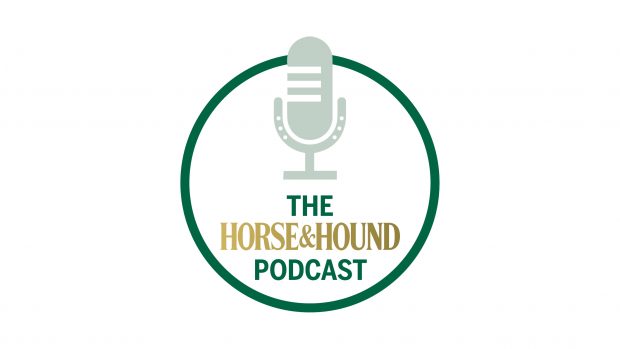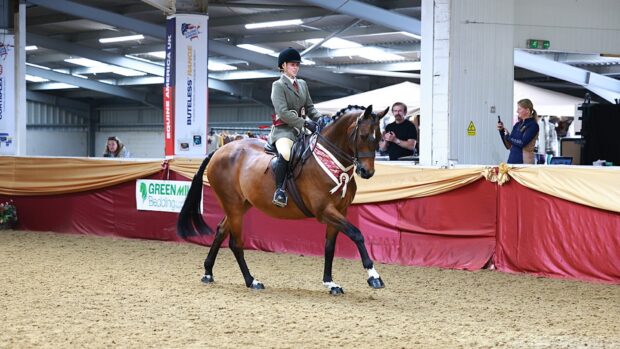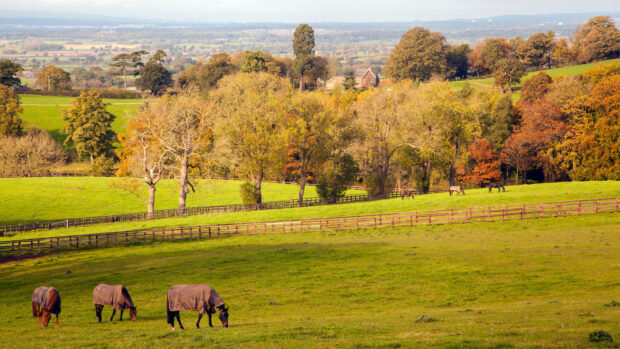“Let your older horse talk to you”, is the advice from the owner of a 28-year-old gelding enjoying his “second chance at an active life”.
Kiki Maurey’s American quarter horse Snippers Soul Rebel (Ché) was retired in 2020 as he was intermittently unlevel, then went very lame in all four feet a year later. He was diagnosed with laminitis and PPID (Cushing’s) as well as issues in his teeth.
Three years of team effort later, including top veterinary and farrier treatment and Kiki’s care, he is back in work and happy.
“When Kiki first saw Ché in his stable, it was love at first sight,” said a spokesman for Seadown Veterinary Group, which treated Ché.
“She’s always loved grey horses and she recalls loving Ché’s big liquid eyes, his large cheeks, tiny ears and a lively intelligence.”
Kiki had painful joints and was considering hanging up her riding boots when she heard about five-year-old Ché. Her now ex-partner thought she had bought an overpriced New Forest pony but “thankfully it was my money, so no contest”, Kiki said.
Kiki competed and trained in western disciplines, settling on reining as her competitive discipline of choice. They were Garden of England Winter Circuit 2010 Rookie Circuit champions, trained with British Reining team member Doug Allen and competed with some of the best in Europe.
Their last competition was in 2012, after which they hacked out until Ché’s first retirement, at which time Kiki bought another horse.
Karolina Kalka, who came to see Ché when he went lame, X-rayed his feet.
“The radiographic study revealed subtle signs of chronic laminitis that had been overlooked for a while, due to a low level of discomfort being masked by the horse,” she said. “I took a blood sample and discovered that he also had early PPID that could have been associated with an insidious onset of laminar separation within the hoof capsule and mild rotation of the coffin bone. It was not that easy to spot as Ché had none of the classical appearance of early-onset PPID, having a good quality coat, preserved reasonable condition of his musculature and a normal demeanour. The horizontal position of the palmar processes of the coffin bone (flattened position) in the left fore hoof was associated with a mild but persistent discomfort exhibited by Che.”
Dental assessment showed he had multiple diastemata (enlarged spaces between his teeth), which had induced periodontal disease and discomfort.
Ché was put on a strict diet with limited turnout and medicated. He lost muscle but his next blood counts were positive, and he was shod in front with mesh and gel to give him support.
His condition improved but Kiki learned she had to be strict with his diet. The PPID affected his hoof quality but an assortment of foot pads and hoof boots kept him comfortable.
“I’ve learned my lesson: I need to be able to see a slight shadow from his ribs, avoid moving the electric fences too much, and avoid cereals, sugar beet, molasses or oil in his feed, giving damped good quality hay instead,” Kiki said. “And whenever the weather allows, put turnout hoof boots and pads on his front feet to protect his naturally thin soles.”
Kiki said Ché’s recovery has been a team effort, but that the horse himself is the key.
“With an exceptional work ethic he nudges me if we don’t ride out every few days,” she said. “A highly charismatic little horse, he fought as much as I did for his rehabilitation and still goes through all the many western dressage exercises in my back field with gusto. This builds muscle strength – even at a walk. Secondly, Karolina has a great mind and she’s been genuinely interested in getting Ché back to work. Finally, working with The Hoof Boutique was essential in finding the right boots for when Ché couldn’t take metal shoes and couldn’t tolerate going barefoot. All this taken together with a new farrier, has worked fabulously.”
Ché shows “no signs of slowing down” despite his age.
“After years of chronic knee pain, I’m now on a waiting list for a knee replacement,” said Kiki. “I’m as lame as a crow but riding western on a highly responsive and intelligent quarter horse allows me to continue being active. Ché keeps himself in self-carriage on very little contact, never trips, needs no kicking on, and is obedient to neck-reining and my voice. When I mount, we feel like one and he returns to me the thrill of freedom of movement and speed I once experienced in my youth. As for getting off, he patiently stands four-square while I carefully heave myself to the ground, doing the same when I mount, positioning himself perfectly by the mounting block, never moving until my old bum settles in the saddle. And then we’re off.”
Kiki’s advice to other owners includes finding a vet who will work with the farrier and being prepared to change habits.
“Let your old horse talk to you,” she said. “Some older horses thrive with having a job.
“Lots of cuddles, blanket changes and grooming, like with us humans, physical comfort brings its own rewards – I think Ché heals me, and I heal him.”
Karolina added that Ché is an “excellent example of an elderly horse that thrives thanks to the owner, who insists on maintaining a good quality of life of her beloved horse”.
“It is a time-consuming and demanding process, but thankfully, is equally rewarding,” she said.
“Geriatric medicine should mean more than just reducing pain originating from poorly defined sources with bute. Resolution of the discomfort can be achieved in many cases and it should be sought, as there can be a reasonable solution easily available that might change not only your horse’s life, but also your own!
“Ché can now enjoy the twilight period of his life to the very fullest extent, and I couldn’t be more proud.”
You might also be interested in:

‘Don’t rule the oldies out!’ 28-year-old ‘pocket rocket’ mare and 75-year-old rider win national title

A ‘special old lady’: mare’s 45th birthday marked with singing and cake

Saddle up and go exploring in these great hoof boots

Subscribe to Horse & Hound magazine today – and enjoy unlimited website access all year round
Horse & Hound magazine, out every Thursday, is packed with all the latest news and reports, as well as interviews, specials, nostalgia, vet and training advice. Find how you can enjoy the magazine delivered to your door every week, plus options to upgrade your subscription to access our online service that brings you breaking news and reports as well as other benefits.




